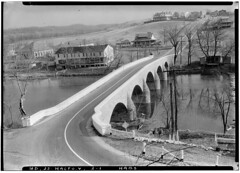
The Wilson Bridge carried the National Road over the Conocoheague Creek, west of Hagerstown, Maryland. The five arch stone bridge, spanning 215 feet, was built by Silas Harry in 1819, at a cost of $9,100. This photo, from the Historic American Buildings Survey, shows the bridge in use, in the 1930s.
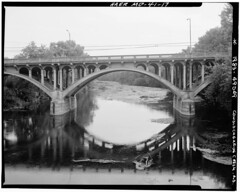
It was superceded in 1937 by this concrete arch bridge.
The stone arch bridge remained in use until June, 1972, when it was damaged by Hurricane Agnes.
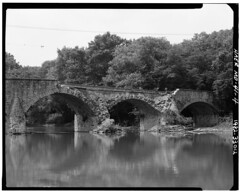
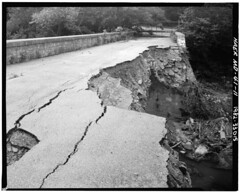
A flood damaged one arch of the bridge in 1982. It was scheduled for demolition, due to safety concerns and the high cost of restoration - estimated to be $300,000-$400,000. However, due to public concern, the bridge was restored and made into a public park.
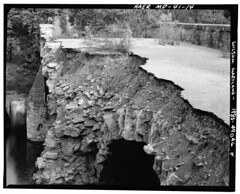
It's interesting to note the rubble filled interior construction of the bridge.
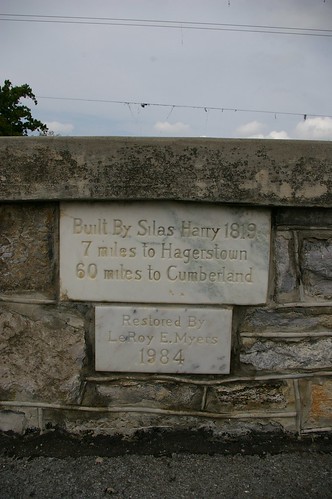
Silas Harry completed the restoration work in 1984.
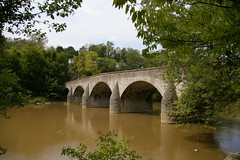
The bridge now stands in excellent condition, ready to last another 150 years.
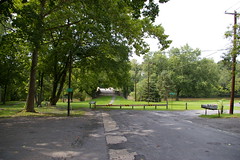
The area leading up to the bridge, from the east, includes several picnic tables and a historical marker.
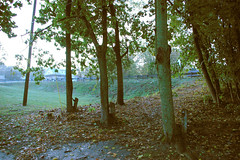
The remains of some old guard rails remain, hinting at a time when the road didn't dead-end into a parking lot.
Aside from the first image, black and white images are by William Edmund Barrett, for the Historic American Buildings Survey.
For additional photographs, see my set of images of the bridge over on Flickr.
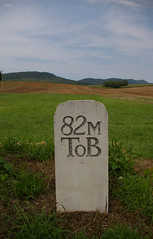
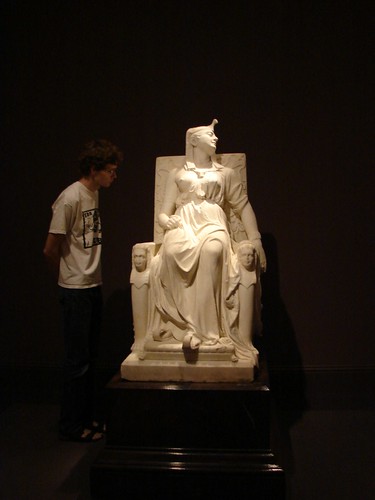
2 comments:
Hello. Wonderful historic and modern photographs. Just a brief clarification.
The bridge was saved almost as an accident.
The Society for Industrial Archaeology arranged a recording field trip as a response to the bridge’s impending demolition, as there were no drawings, and the existing photographs were insufficient as a permanent record of a major soon to be lost landmark. ROBERT M. VOGEL Curator of Civil and Mechanical Engineering at the Smithsonian Institution and ERIC DELONEY, Chief of the Historic American Engineering Record, men instrumental in our understanding of the history of American engineering and the preservation of remaining historic structures, initiated and led the Society’s recording efforts. Shortly before demolition was to begin, perhaps 50 of us arrived at the site for measurements and photographs.
We spent the day crawling over the bridge, and wading and canoeing under it to measure its spans, photograph stonework, etc. We shared out picnic lunches and worked all day. Lots of residents stopped by to ask what was going on. Many had not heard the bridge was to be destroyed. Among them was a construction company owner. We left at the end of the day, very tired, exposed to poison ivy, and depressed that the bridge would be gone soon.
Unknown to us, the CONSTRUCTION COMPANY OWNER was very impressed with the history and importance of the bridge, and public reaction to its impending demolition. He contacted the county and essentially offered to restore the bridge for the same price as demolition. I’m afraid I don’t recall his name, but he and Mr. Vogel and Mr. Deloney are the heroes here. He saved the bridge because of the Society’s recording effort organized by Vogel and Deloney.
The real surprise is that no one in the society knew what’d happened. I spotted a small article in a western Maryland paper, and called Robert and Eric, who were as surprised as I.
The moral? It’s hard to destroy a much loved or publicly valued landmark, nothing beats a sympathetic and in this case very generous contractor, except perhaps giving someone the chance to put on a white hat and ride to the rescue!
Gregory Hubbard
Sanford, Maine
My apologies! I my posting, I neglected to say how much I enjoyed reading your site! Thanks very, very much. Gregory Hubbard.
Post a Comment